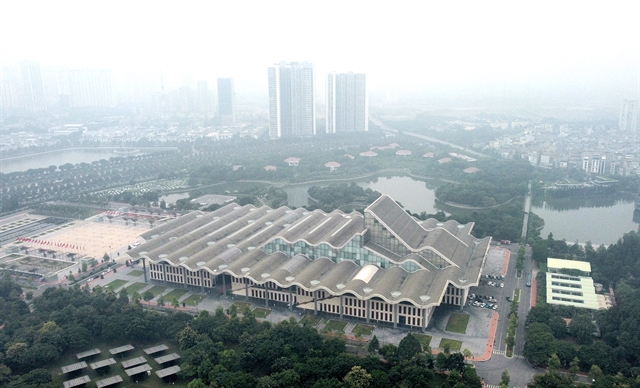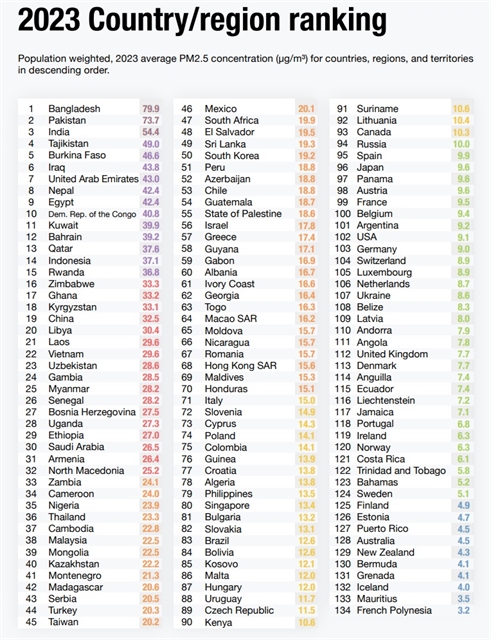 Environment
Environment

 |
| Air pollution in Nam Từ Liêm District, Hà Nội, in November 2023. — VNA/VNS Photo Hoàng Hiếu |
HÀ NỘI — Việt Nam has been named the country with second most polluted air in 2023 in Southeast Asia following Indonesia, and 22nd in global ranking, according to the latest annual report from the Swiss organisation IQAir.
The capital Hà Nội was the city with the unhealthiest air in the country last year. It was ranked the 8th most polluted city in the world (43.7 points), closely tailing Indonesia's Jakarta (43.8). These are the only two Southeast Asian entries in the top 10. The two most polluted capital cities are India's New Delhi and Bangladesh's Dakha.
According to the report, in 2023, Việt Nam saw a nearly 9 per cent increase in PM2.5 levels, returning to pre-pandemic levels with an annual average of 29.6 µg/m3.
For the third consecutive year, approximately eight million residents in Hà Nội experienced escalating PM2.5 concentrations, reaching 43.7 µg/m3 in 2023, nearly nine times higher than the WHO annual PM2.5 guideline.
Across all Vietnamese cities with historical data available, PM2.5 concentrations rose in 2023, with a third of these cities reporting annual concentrations exceeding the WHO guideline by seven to ten times. None of the cities in Việt Nam met the WHO annual PM2.5 guideline level in 2023.
Air pollution in Việt Nam stems from various sources including an aging vehicle fleet, coal power plants, industrial activities, indoor coal and biomass cooking stoves, ineffective waste management practices and agricultural practices.
According to the World Bank, approximately 80 per cent of rice straw is burned in the Mekong Delta following harvest, contributing a great deal to pollution in the region.
The report said climate conditions worsen air quality problems in this region last year, with El Nino causing belated arrival of rainy season which can lessen the levels of pollutants in the air.
Power generation, industrial operations, vehicle emissions and open burning remain the primary contributors to PM2.5 pollution in the region.
Out of the 357 cities surveyed across Southeast Asia, only three managed to meet the WHO's annual PM2.5 guideline value of 5 µg/m3, a decrease from eight cities in the region in 2022. The year 2023 witnessed significant spikes in PM2.5 levels, with seven regional cities in Indonesia, Việt Nam, and Thailand surpassing the WHO's annual PM2.5 guideline levels by more than tenfold. This is a stark contrast to 2022 when no city exceeded an annual average concentration of 50 µg/m3.
 |
| The rankings of all countries included in IQAir's 2023 World Air Quality Report. |
Persisting problem
For the first months of 2024, air issues continue to plague Hà Nội, with some days reaching hazardous level (300+) in IQAir index, topping the world.
The smog enveloping the city, especially during the early morning hours, is no stranger to the city's residents. From a distance, a thick layer of smog can be seen covering many high-rise buildings and streets, prompting health concerns.
According to experts, the northern region and Hà Nội in particular experiences "air pollution season" from October to March every year.
Breathing daily in this 'smoggy' environment not only causes physical health issues such as pneumonia, asthma but also affects people's mental health. Surveys at many major hospitals in the area show an overload of respiratory patients in all age groups.
At the 108 Military Central Hospital, many elderly people visit for examination with anxiety and feelings of exhaustion.
Nguyễn Văn Hùng, in Hai Bà Trưng District, has witnessed prolonged symptoms of coughing with breathing difficulties for a week. He said he has a history of respiratory-related illnesses, so changing weather makes it very difficult for him to breathe. The current air situation greatly affects those with weak respiratory systems like him.
At Thanh Nhàn Hospital, the number of people queuing early in the morning for medical examination has increased sharply. Most of those who come here suffer from respiratory diseases, mainly asthma and mostly children.
Production and business activities, daily life of the people are also affected to some extent by dirty air.
Many businesses and shops have to delay opening hours, implement work later to reduce the impact of pollution on workers, with many reporting uptick in sick leaves due to respiratory issues.
In agriculture and animal husbandry, air pollution can disrupt the ecological balance, with plants shedding leaves, unable to bloom and bear fruit, resulting in losses.
Nguyễn Thị Hoan, the owner of a rice field in Sóc Sơn District, said she had to increase fertilisation, and closely monitor the weather to timely protect the rice seedlings. Air pollution also became a problem to those who work in the fields from early morning, having to wear masks all the time makes the already demanding physical labour much more fatiguing.
Air pollution also dents the image of Hà Nội in the eyes of tourists.
Vũ Minh Đức, a tourist from HCM City, was surprised when Hà Nội seemed to be always shrouded in fog and dust.
"Our group loves to admire Hà Nội in the early morning," Đức said.
"However, recently, the weather has been humid, foggy, we dare not go out for fear of pollution. That also makes the whole group's trip less enjoyable than before."
Recently, at the 31st session of the Standing Committee of the National Assembly, when commenting on the draft amended Capital Law, Chairman of the National Assembly Vương Đình Huệ said that traffic jams and environmental pollution remain weak points of Hà Nội.
"What's the point of a developing capital city when the environmental pollution and traffic congestion persist? Many foreigners says they like living in Hà Nội, but they are concerned the most with air pollution here," he said, adding that the revised capital law will need to empower the capital city's authorities to make timely adjustments on issues such as setting exhaust emission standards for road vehicles.
Senior environmental experts from the World Bank in Việt Nam also shared the notion of emission control, together with stronger development of public transport network to help reduce number of personal road vehicles.
Additionally, they also proposed Hà Nội create mechanisms to encourage businesses to adopt clean production models, step up management of air pollution from industrial activities through stringent oversight and strict penalties for violations, expedite the construction of advanced waste incineration plants and waste treatment facilities, promoting urban afforestation.
Additionally, there is a need to accelerate the relocation of universities and office headquarters out of downtown areas to reserve land for green space development. — VNS